There are many things homeowners can do to ensure their siding doesn’t succumb to damage from the elements. Proper maintenance, including regular inspections for signs of damage, proper gutting and downspouting, and installation of gutter guards can help keep your siding looking new for years to come. Additionally, applying a protective coating or sealing any cracks or holes in the siding can help prevent water and other elements from damaging the material. Additionally, controlling moisture and vapor levels in your home can also help prevent damage from occurring.
DISCLAIMER: The information provided in this article is for informational purposes only and is not intended to be a substitute for professional advice. While we have taken steps to ensure the accuracy of the information contained herein, we cannot guarantee its accuracy or completeness. We strongly recommend that you consult with a qualified professional before making any decisions regarding your home’s siding. Advance Roofing LLC has been proudly providing Spokane, WA area residents with top quality roofing solutions for many years.
Definition of Siding
The exterior walls, roof and exterior windows of a house are most commonly made of wood, metal, plastic or vinyl. These materials can be painted or stained to give the house its unique look. Some materials, like metal and plastic, are also treated with a sealant that makes them resistant to weathering and decay. Siding is one type of material that is often used on the exterior of a house. Siding is a board or panel that is attached to the wall using nails or screws. It is usually made of wood, but other materials like vinyl can also be used.
Siding is usually attached to the wall using nails or screws. When siding is new, it is often treated with a sealant that makes it resistant to weathering and decay.
purpose of siding protection: Siding is one type of material that is often used on the exterior of a house. Siding is a board or panel that is attached to the wall using nails or screws. It is usually made of wood, but other materials like vinyl can also be used. When siding is new, it is often treated with a sealant that makes it resistant to weathering and decay.
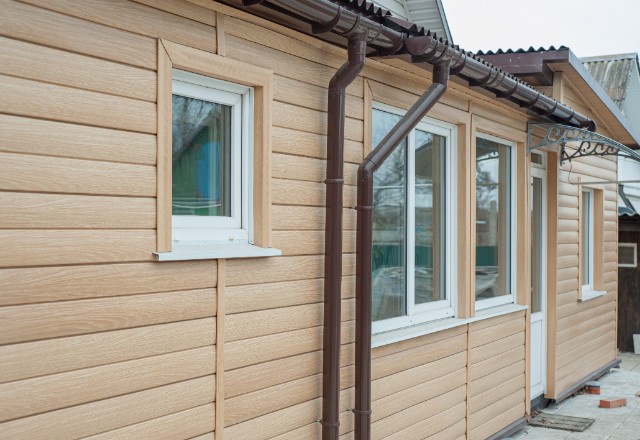
Purpose of Siding Protection
Many homeowners opt to protect their siding from the elements with a sealant or treatment. This is done to give the exterior of the home an extended lifespan and to make it resistant to weathering and decay. There are many benefits to doing this, including:
-Extended lifespan: Siding can last many years if it is treated correctly. Weathering and decay can cause siding to deteriorate prematurely, and a sealant or treatment can help prevent this.
-Resistant to weathering and decay: Sealants or treatments can help keep siding looking new for longer by making it resistant to the elements. This means that it will not rust, discolor or lose its shape over time.
-A unique look: A well-maintained exterior can give your home a unique look that sets it apart from others. This is something that you may want if you are looking for an upgrade or want your home to stand out from the crowd.
When choosing a sealant or treatment for your siding, be sure to consider all of the factors involved. This includes the material that your siding is made of, the climate where you live and the type of use that your home will see.
Types of Damage
Damage to siding can be caused by a variety of factors, including weathering and decay, UV light, wind, insects and animals. Many homeowners choose to protect their siding with a sealant or treatment to extend the lifespan of the exterior material and to make it resistant to these various types of damage. When choosing a sealant or treatment for your siding, be sure to consider all of the factors involved. This includes the material that your siding is made of, the climate where you live and the type of use that your home will see.
If you have water damage on your property, don’t wait to call a professional! A sealant or treatment can help to protect your siding from further damage and make the restoration process easier.
Water Damage
Water damage can be a major problem for your siding, causing serious and expensive repairs. It can occur from natural disasters such as floods or heavy rainstorms, but it can also happen due to faulty plumbing or roof leaks. If left unaddressed, water damage can cause your siding to rot and decay over time, posing a risk to the safety of your home and family.
To protect your siding from water damage, it’s important to take the proper precautions. Make sure that all of your pipes are in good working order and that any roof leaks are addressed promptly. You should also consider investing in a sealant or treatment that is designed to repel water, which can help to keep moisture away from your siding and extend its lifespan. Additionally, it’s important to check for signs of water damage on a regular basis so that you can take action quickly if needed.
By taking these simple steps, you can help ensure the longevity of your siding and protect against any potential water damage in the future.
Hail Damage
Hail damage can be a serious issue for your siding, as the impact of hail can cause dents or even cracks in your sidings material. It not only affects the appearance of your home, but it can also lead to moisture seeping into walls and insulation, resulting in mold growth.
To protect against hail damage, the best thing you can do is to make sure that your siding is properly maintained and inspected regularly. Regular cleaning and inspections can help to identify any small issues before they become more serious. Additionally, you may want to consider installing storm shutters or covers on windows and doors to protect against hail during severe weather events.
For extra protection, you may also want to look into investing in impact-resistant siding materials. These materials are designed to be more resistant to impacts from hail and other debris, making them ideal for areas with frequent storms. Investing in impact resistant siding may cost a bit more upfront, but it could save you from costly repairs down the line if severe weather strikes your area.
By taking these precautions, you can help ensure that your siding stays safe from hail damage and keep your home looking great for years to come.
Woodpecker Damage
Woodpecker damage may not be as serious an issue as hail damage, but it can still cause significant damage to your siding. Woodpeckers have a habit of pecking and drilling holes into wood and other siding materials in search of food or to build nests, which can leave your siding looking unsightly and damaged.
To protect against woodpecker damage, you should make sure to keep your trees trimmed back away from the house and remove any dead branches that could provide easy access to your siding. Additionally, you may want to consider installing a repellent such as bird netting around the affected area or even hanging shiny objects like CDs or wind chimes near the area to deter them from returning.
If you already have woodpecker damage on your siding, there are a few steps you can take to repair it. Sanding down the affected area with sandpaper is one option; however, if the wood is severely damaged then you will need to replace the boards completely. Additionally, painting over the repairs with a matching color can help blend them into the existing paint job for a more seamless look.
By taking these preventative measures and acting quickly when necessary, you can help keep your siding safe from woodpecker damage and keep your home looking its best for years to come.

Temperature Fluctuation Damage
Temperature fluctuations can cause a lot of damage to siding, especially if it is not properly maintained. Siding can expand and contract as temperatures change, which can cause cracks and breaks in the material leading to water infiltration. Additionally, extreme temperature changes can also cause paint to chip and blister, leaving your home looking unsightly.
To protect your siding from temperature fluctuation damage it is important to keep up with regular maintenance. Inspect your siding for any signs of cracking or wear-and-tear, and make sure that any exposed gaps are filled with a quality sealant. Additionally, painting your siding every few years will help protect it from harmful UV rays and other environmental elements that may contribute to wear-and-tear over time.
If you already have some damage due to temperature fluctuations, there are a few steps you can take to repair it. For minor issues like cracking or peeling paint, sanding down the affected area and reapplying a coat of high-quality primer followed by two coats of exterior paint should do the trick. If more significant damage has occurred then you may need to replace the boards completely before repainting them for added protection against further weathering.
By taking these preventative measures and acting quickly when necessary, you can help keep your siding safe from temperature fluctuation damage and keep your home looking its best for years to come.
Types of Siding Materials
Siding is a necessary element in safeguarding your home from weather conditions. There are numerous siding materials available in the market, such as vinyl, wood, aluminum, and fiber cement. Each one offers its own unique benefits, so it’s important to understand the differences between them when making a decision about which material is right for your home.
Vinyl siding is a popular choice due to its affordability, durability and easy maintenance requirements. It also comes in a wide range of colors and can be used to mimic the look of traditional wood siding without the need for painting or staining.
Wood siding provides a more natural aesthetic than other types of materials but requires regular upkeep such as staining and painting in order to keep it looking its best over time. It also tends to be more expensive than other options but can offer excellent insulating properties that help reduce energy costs in the long run.
Aluminum siding is another great option that has become increasingly popular due to its low-maintenance appeal, affordability, and ability to withstand extreme weather conditions. It does require regular cleaning in order to maintain its appearance, however.
Finally, fiber cement siding is an incredibly durable option that looks just like real wood but requires much less maintenance over time. Its cost may be higher initially but its longevity makes it an excellent long-term investment for those who want lasting protection from the elements with minimal upkeep required over time.
No matter which type of material you choose for your home’s exterior, proper installation and regular maintenance are essential if you want it to offer maximum protection throughout its lifetime.
No matter which type of siding you choose for your home, making the right decision for your budget and lifestyle can provide you with long-lasting protection from the elements. And if you’re looking for a durable, low maintenance option that can withstand extreme weather conditions, then fiber cement siding may be the perfect choice for you!
Fiber Cement
Fiber cement siding is a great option for homeowners looking for a durable, low maintenance solution that can withstand extreme weather conditions. This type of siding is made out of a combination of cement and wood fibers which makes it incredibly strong and resistant to fire, pests, and rot. Additionally, it can be painted any color you choose so you can customize the look of your home’s exterior.
When it comes to installation and upkeep, fiber cement siding is relatively easy to maintain and doesn’t require much work once installed. It needs to be checked every few years for signs of damage or wear but other than that it doesn’t need regular painting or staining like wood siding does. This makes it an ideal choice for those who want lasting protection from the elements with minimal upkeep required over time.
Overall, fiber cement siding is an excellent long-term investment for homeowners looking for quality protection without the hefty price tag associated with other types of materials. With its affordability, durability, and low maintenance requirements this material offers a great balance between cost and performance that will keep your home looking beautiful for years to come!

Vinyl Siding
Vinyl siding is a great solution for those looking to give their home exterior a facelift. It’s low-maintenance, affordable, and comes in a variety of colors and styles so you can customize the look of your home however you want. It’s also incredibly durable and can withstand extreme weather conditions like wind, rain, snow, and hail without becoming damaged.
When it comes to installation and upkeep, vinyl siding is fairly easy to install yourself or have done by a professional. It requires very little maintenance once installed as well; it doesn’t need to be painted or stained every few years like wood siding does. Additionally, it won’t rot or warp over time which makes it an ideal choice for those looking for long term protection from the elements without any additional cost down the line.
Overall, vinyl siding is an excellent option for homeowners looking for an affordable yet durable solution that won’t require too much work over time. Its ability to withstand extreme weather conditions combined with its minimal maintenance requirements make this material a great choice for anyone who wants lasting protection from the elements without breaking the bank!
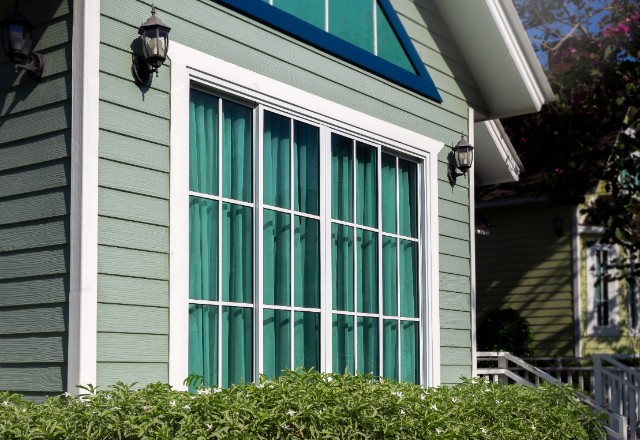
Wood Siding
Wood siding is a popular choice for those who want to give their home that classic look and feel. It’s a timeless material that can be stained or painted in any color you desire, giving you the ability to customize your exterior exactly how you envision it. Wood siding also has excellent insulating properties, meaning it helps keep your home warm in the winter and cool in the summer.
When it comes to installation, wood siding is easy to install yourself or have done professionally. However, unlike vinyl siding, wood siding requires more maintenance over time such as regular staining or painting every few years to protect it from damage due to weathering. Additionally, wood siding can warp over time if not properly treated and maintained which may require additional repairs or replacement down the line.
Overall, wood siding is an attractive option for those looking for a timeless aesthetic with good insulation properties but should be aware of the extra maintenance required for this material down the line. With proper care and upkeep though, this material can last for many years without needing any additional repairs!
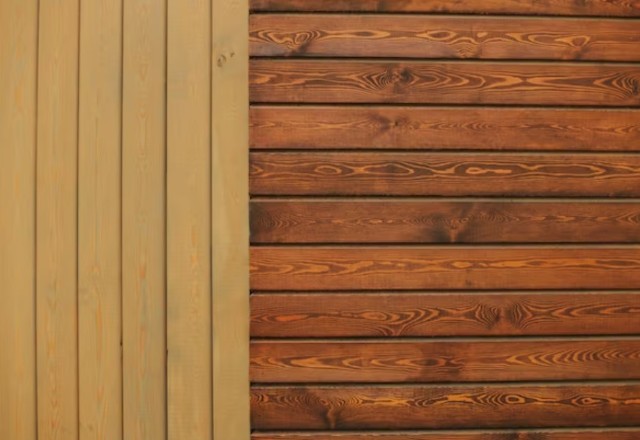
Proper Maintenance to Protect from Damage
Regular maintenance is essential for keeping your wood siding looking great and protecting it from damage. To keep your wood siding in top condition, you should inspect the material periodically for signs of wear and tear such as warping or cracking. Additionally, be sure to check for any loose nails or screws that may need to be tightened or replaced.
You should also apply a fresh coat of paint or stain every few years to help protect your wood siding from UV rays and other damaging elements. If you’re looking for a more natural look, a clear sealant can be applied as well which will help protect the wood from moisture damage while still allowing its natural beauty to shine through.
Finally, be sure to clean your siding regularly with an appropriate cleaner designed specifically for wood. This will help prevent dirt and debris buildup which could cause premature wear and tear on the material over time. With these simple steps, you can enjoy the beauty of your wood siding for years to come!
Taking care of your wood siding is essential for preserving its natural beauty and protecting it from the elements. With a few simple steps, you can keep your siding looking great for many years to come! And don’t forget to keep your gutters and downspouts clean too – we’ll tell you how in our next section!
Cleaning Gutters and Downspouts
Gutters and downspouts play an important role in protecting your home’s siding from damage. It’s essential to ensure they are regularly cleaned and maintained. Here are some tips for keeping your gutters and downspouts clean:
First, check the gutters at least once a month for any leaves, twigs or other debris that may have accumulated. If you notice any clogs, be sure to remove them as soon as possible before they cause water to back up and potentially cause flooding or damage to the siding.
Additionally, inspect the downspouts periodically for blockages or excess dirt buildup that can inhibit proper drainage. If necessary, use a garden hose with a nozzle attachment to clean out the downspout from the top of the roof. This will help ensure that all debris is properly removed and won’t interfere with water drainage.
Finally, keep an eye on your gutters during heavy rainstorms or snowfall periods. Make sure there isn’t excessive runoff that could lead to overflowing which can cause further damage to your siding over time.
By following these simple steps, you can help ensure that your gutters and downspouts are functioning properly and helping protect your home’s siding from potential water damage!
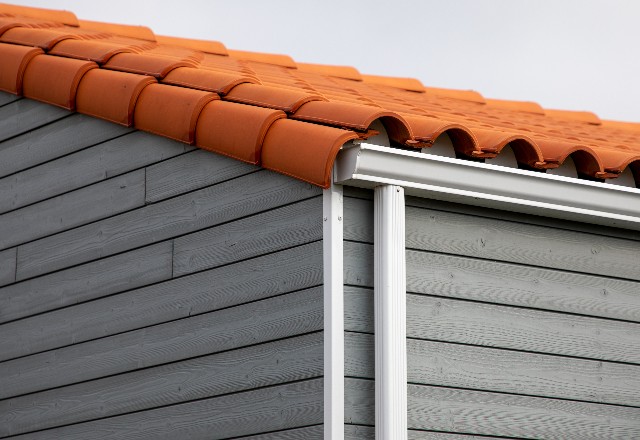
Regularly Inspecting for Signs of Damage
Regularly inspecting your siding for signs of damage is an important step in protecting your home. Even if you think everything looks fine, it’s important to inspect the siding at least once a year to make sure there aren’t any cracks or missing pieces that could lead to water damage. Here are some tips for inspecting the siding:
Start by examining all visible areas of the siding, such as around windows and doors, where water can easily enter and cause damage. Pay attention to any spots where paint may have peeled away as this can be an indication of underlying moisture issues. Also, check for any warping or bulging that could indicate excessive exposure to water or other elements.
In addition, examine any places where two different types of materials meet, such as wood and vinyl siding. If these seams are cracked or worn away, they should be sealed with caulk as soon as possible to prevent water from entering the area and causing further damage.
Finally, look for signs of insect infestations such as small holes in the siding or other evidence of pests like ants or termites. If you find anything suspicious take care of it right away before it becomes a bigger issue down the line.
By regularly inspecting your home’s siding you can help keep it in good condition and protect it from potential water damage!
Installing Gutter Guards
Gutter guards are an effective way to protect your home from water damage caused by clogged gutters. Installing gutter guards is a relatively simple process that can help keep your gutters free of leaves, twigs, and other debris. Gutter guards come in various styles and materials such as plastic, metal, and foam, so it’s important to choose the right one for your home.
To begin the installation process, first determine where you want to place the gutter guard and measure the area accordingly. After that, cut the gutter guard to size using tin snips or a hacksaw. Once cut, attach the gutter guard along the length of your gutter using screws or nails depending on material type. Make sure to secure it firmly and use caulk around all seams for a water tight seal. Lastly, repeat this process until all areas are covered appropriately.
Gutter guards are an easy way to prevent water damage from clogged gutters and can save you time when it comes to cleaning out your gutters each season!
Sealing any Cracks or Holes in the Siding
Cracks and holes in your siding can lead to water damage, so it’s important to repair them as soon as you notice them. The good news is that sealing these areas is relatively easy and requires only a few simple steps.
First, use a putty knife or stiff brush to remove any loose paint or debris from the area of the crack or hole. Then, use a vacuum cleaner to clean the area and make sure that it’s free of dirt and dust.
Next, apply a clear sealant around the crack or hole with a caulking gun. Make sure that the sealant covers both sides of the damaged area and fills in any gaps completely. Finally, allow the sealant to dry completely before painting over it with an exterior paint that matches your siding color.
Sealing cracks and holes in your siding is an easy way to keep water out and protect your home from potential damage. It’s also important for improving curb appeal since repairing visible cracks and holes can help improve the look of your home’s exterior.
Re-painting or Resealing the Siding Periodically
Re-painting or resealing your siding periodically is a great way to keep it looking good and protect it from damage. If you live in an area with fluctuating temperatures or humidity, it’s important to re-paint or reseal your siding every three to five years in order to keep the paint and sealant in good condition.
If you decide to re-paint, start by using a power washer to remove any dirt and debris from the siding. Once it’s clean, use a putty knife or stiff brush to scrape off any loose paint, then use a vacuum cleaner to remove any remaining dust and dirt. Next, apply an exterior paint that matches the color of your existing siding. Make sure that the new coat of paint covers the entire area thoroughly and allow it to dry completely before applying another coat if needed.
If you decide to reseal instead, follow the same steps as above but use a clear sealant instead of paint. Once you’ve applied the sealant, make sure that both sides of each crack or hole are covered completely and allow it to dry before painting over it with an exterior paint if desired.
Taking care of your siding can help increase its longevity and protect against water damage over time. Re-painting or resealing periodically is an easy way to maintain its appearance while also protecting your home from potential damage caused by moisture accumulation over time.
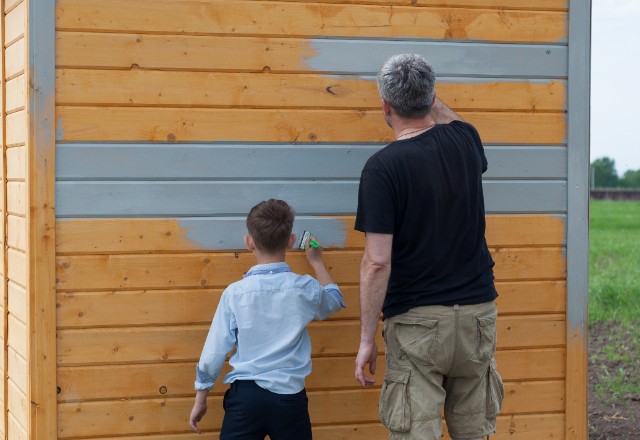
Applying a Protective Coating to the Siding
Applying a protective coating to your siding is an effective way to protect it from damage. The first step is to clean the siding thoroughly with a power washer to remove any dirt and debris. Then, use a putty knife or stiff brush to scrape off any loose paint, followed by vacuuming or wiping down the area with a damp cloth. Once it’s clean and dry, you can apply a protective coating such as elastomeric coating or acrylic sealer. Elastomeric coating is ideal for siding that’s already been painted because it adds an extra layer of protection while also allowing the existing paint color to show through. Acrylic sealer is great for unpainted siding because it provides a waterproof barrier and helps prevent water damage over time. Make sure that you follow the instructions on the product carefully when applying and allow ample drying time before exposing the surface to moisture again. Taking care of your siding with a protective coating can go a long way in keeping it looking good for years to come!
Ensuring Adequate Ventilation
Ventilation is an important part of keeping your home safe and healthy. Not only does it provide fresh air, but it also helps to control humidity and moisture levels which can cause mold growth and other types of damage. To ensure adequate ventilation in your home, start by inspecting the windows and doors for any cracks or openings that could be letting in unwanted air. If needed, add weatherstripping around the edges of these openings to help seal them off. In addition, make sure your vents are clear from any blockages such as furniture, rugs, or curtains. Last but not least, install exhaust fans in bathrooms and kitchens to help expel excess moisture from the air. Taking these steps will help to ensure that your home has adequate ventilation year round!
Controlling Excess Moisture and Water Vapor
Controlling excess moisture and water vapor is essential to protecting your siding from damage. Moisture can cause mold growth, decay, and rot in wood, vinyl, and other types of siding materials. To control moisture levels in the home, start by inspecting for any areas that may be prone to water damage such as leaky pipes or roofs. Make sure these are repaired promptly to avoid further damage. Additionally, consider installing a dehumidifier to help reduce indoor humidity levels. Controlling the relative humidity of your home will not only protect your siding but also make it more comfortable throughout the year! Last but not least, ensure that you are keeping gutters and downspouts clear so that water doesn’t accumulate around your home’s foundation. Taking these steps will help keep your siding dry and safe from unwanted moisture and water vapor!
Potential Damages & Prevention Strategies
Your home’s exterior is one of its most visible features, and it’s important to protect it from damage. There are a few ways to do this.
One way is to have your home properly maintained. Make sure the siding is caulked and sealed, and that any leaks are fixed. Regularly clean the gutters and downspouts, and check for signs of water damage (such as rot or mold) before it becomes a problem.
Another way to protect your siding is to use proper installation techniques. Make sure the siding is installed correctly, using special supports if necessary. Follow the manufacturer’s instructions for installing trim and flashing.
And finally, be aware of potential threats to your siding. Keep an eye out for weather conditions that could lead to hail, wind, or rain damage. Be especially cautious in areas prone to flooding or ice damage. If you see any sign of damage, take action right away: call a contractor, consult a homeowner’s guide, or contact your insurance company.
One way to protect your home from damage is to keep it properly maintained. Make sure the siding is caulked and sealed, and that any leaks are fixed. Regularly clean the gutters and downspouts, and check for signs of water damage (such as rot or mold) before it becomes a problem. Additionally, use proper installation techniques when installing trim and flashing. And be aware of potential threats to your home, such as weather conditions that could lead to hail, wind,
Recognizing Potential Causes of Damage
Damage to your home’s exterior can be costly and time-consuming to repair. It’s important to be aware of the potential causes of damage, so you can take steps to prevent it. One way is to have your home properly maintained. Make sure the siding is caulked and sealed, and that any leaks are fixed. Regularly clean the gutters and downspouts, and check for signs of water damage (such as rot or mold) before it becomes a problem. Additionally, use proper installation techniques when installing trim and flashing. And be aware of potential threats to your home, such as weather conditions that could lead to hail, wind, or rain damage. If you see any sign of damage, take action right away: call a contractor, consult a homeowner’s guide, or contact your insurance company.
Conclusion
Now that you are familiar with some of the common causes of home exterior damage, take steps to protect your home from these hazards. Regularly maintain your siding and trim, caulk and seal any leaks, clean gutters and downspouts, and use proper installation techniques when installing trim and flashing. Be aware of potential weather conditions that could lead to hail, wind, or rain damage. If you notice any sign of damage on your home, take action right away.



 509-201-4190
509-201-4190
